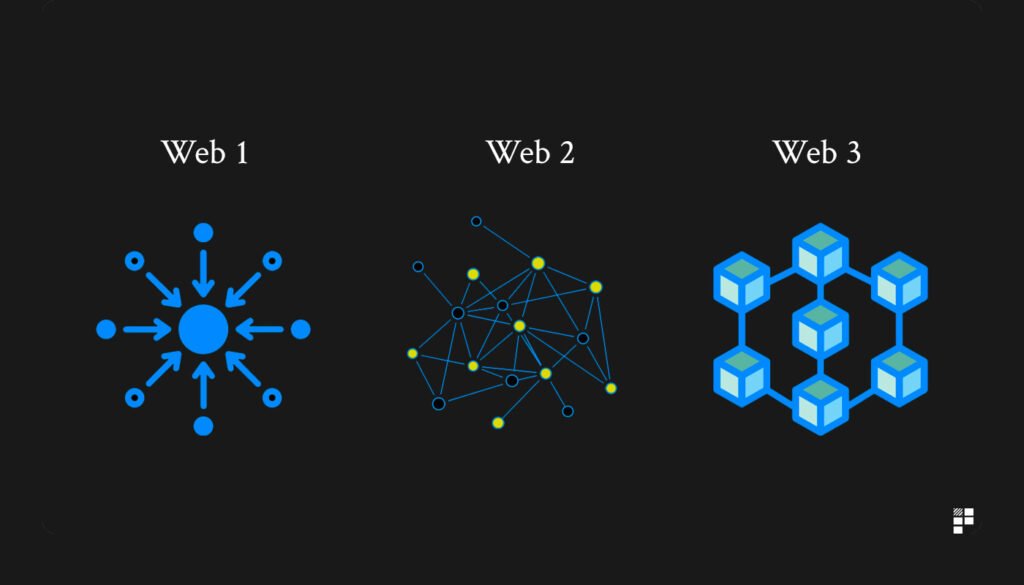The terms Web3 and cryptocurrency (crypto) often spark confusion, frequently used interchangeably in discussions about blockchain and decentralization. Are Web3 and crypto the same thing? The short answer is no. While they are closely connected and often overlap, they are not identical concepts. Crypto refers mainly to digital currencies like Bitcoin, Ethereum, and other blockchain-based tokens, whereas Web3 is a broader concept that describes the next generation of the internet built on decentralization, blockchain technology, and user ownership.
However, they are distinct concepts with unique roles in shaping the future of technology and finance. While crypto refers to digital currencies like Bitcoin and Ethereum, powered by blockchain for secure, decentralized transactions, Web3 envisions a broader, user-controlled internet built on similar principles. Understanding their differences, similarities, and how they interlink is vital for anyone exploring decentralized finance (DeFi), non-fungible tokens (NFTs), or the evolving digital economy in 2025. This article breaks down the major facts, key points, and why distinguishing between Web3 and crypto matters for enthusiasts, investors, and developers navigating this transformative space.
What is Web3? The Future of a Decentralized Internet
Web3, often called the “next generation of the internet,” is a paradigm shift from the centralized Web2 model dominated by tech giants like Google and Amazon. Coined by Ethereum co-founder Gavin Wood, Web3 leverages blockchain to create a decentralized, user-centric web where individuals control their data, identities, and digital assets. Unlike Web2’s “read-write” model, Web3 is a “read-write-own” ecosystem, empowering users through decentralized applications (dApps), decentralized autonomous organizations (DAOs), and NFTs for unique digital ownership.
Key points include its reliance on blockchain for transparency, interoperability across platforms, and resistance to censorship. Web3 applications span far beyond finance—think decentralized social media, metaverse environments, or secure digital identities via self-sovereign credentials. However, challenges like high energy consumption in proof-of-work blockchains and scalability issues persist, making Web3 a work in progress with immense potential to redefine online interactions.
Web3 is the decentralized web, envisioned as the successor to Web2, where control shifts from centralized platforms (like Facebook, Google, and banks) to users themselves.
- Blockchain-based – Runs on decentralized networks instead of centralized servers.
- User-Owned – Data, identity, and assets are controlled by the individual, not corporations.
- Smart Contracts – Automated agreements that execute without intermediaries.
- Applications (dApps) – Decentralized apps that function without a single controlling entity.

What is Crypto? The Backbone of Digital Finance
Cryptocurrency is a form of digital or virtual currency secured by cryptography and typically operates on decentralized blockchain networks. Introduced with Bitcoin in 2009, crypto was designed to enable peer-to-peer transactions without intermediaries like banks, offering lower fees and global accessibility.
Key examples include Bitcoin, a store of value with a fixed 21-million-coin supply, and Ethereum, which supports smart contracts—programmable agreements executed automatically on the blockchain. Major facts about crypto include its market volatility, driven by speculation and adoption, and its diverse use cases: from cross-border payments to investment assets and utility tokens for accessing services within specific platforms.
As of 2025, crypto has gained mainstream traction, with institutional investments and Bitcoin ETFs signaling broader acceptance. Yet, it remains primarily a financial tool, distinct from the expansive vision of Web3, focusing on disrupting traditional finance (TradFi) and fostering financial inclusion for the unbanked.
- Cryptocurrency (crypto) is a subset of blockchain technology focused on digital, cryptographically secured assets that can be used for transactions, investments, and decentralized finance (DeFi).
- Examples: Bitcoin (BTC), Ethereum (ETH), Solana (SOL).
- Primary Use: Digital payments, value transfer, and decentralized finance.
- Technology: Runs on blockchain but not all blockchains are cryptocurrencies.
How Web3 and Crypto Are Connected?
While Web3 is the overall vision of a decentralized internet, crypto is one of the main tools that powers it.
- Crypto provides the financial layer of Web3.
- Tokens are used for governance, staking, rewards, and payments in Web3 ecosystems.
- Many Web3 apps (like Uniswap, OpenSea, Axie Infinity) rely on cryptocurrencies for their operations.
Key Differences: Scope, Purpose, and Technology
While Web3 and crypto both utilize blockchain, their differences are stark.
First, scope: Crypto is narrowly focused on digital currencies and tokens, serving as a medium of exchange, store of value, or access mechanism within ecosystems. Web3, conversely, is a holistic vision encompassing the entire internet, aiming to decentralize everything from social networks to cloud storage.
Second, purpose: Crypto seeks to revolutionize finance by offering alternatives to fiat systems, while Web3 targets broader systemic change, challenging centralized control by Big Tech and promoting user sovereignty.
Third, technology: Crypto primarily uses blockchain for secure value transfer, whereas Web3 integrates additional technologies like decentralized storage (e.g., IPFS) and smart contracts for diverse applications like governance or content creation.
For example, you can buy Bitcoin without engaging with Web3, but Web3 platforms like decentralized marketplaces often require crypto for transactions or incentives. As of 2025, crypto enjoys wider adoption, while Web3 remains experimental, with projects like decentralized social platforms still scaling.
| Feature | Web3 | Crypto |
|---|---|---|
| Definition | Decentralized internet concept | Digital currencies and tokens |
| Scope | Broad – includes apps, DAOs, NFTs, DeFi | Narrow – focuses on financial transactions |
| Core Technology | Blockchain, smart contracts | Blockchain, cryptography |
| Purpose | Give users control over data and assets | Enable peer-to-peer value exchange |
| Example | Ethereum-based dApp | Bitcoin, Dogecoin |
Where Web3 and Crypto Overlap?
Despite their differences, Web3 and crypto share critical synergies. Both rely on blockchain’s decentralized ledger for immutability, security, and transparency, using consensus mechanisms like proof-of-stake to validate transactions. Crypto often powers Web3 ecosystems—Ethereum’s ETH, for instance, pays for gas fees in dApps, while tokens incentivize participation in DAOs. Both aim to reduce reliance on centralized authorities, whether banks for crypto or tech monopolies for Web3.
They also face similar hurdles: regulatory uncertainty, environmental concerns from energy-intensive blockchains, and the need for user-friendly interfaces to drive mass adoption. These overlaps make crypto a foundational pillar of Web3, as tokens enable economic models like play-to-earn gaming or creator-driven NFT marketplaces, blending financial and technological innovation.
Why It Matters in 2025: Opportunities and Challenges
Distinguishing Web3 from crypto is essential for navigating their ecosystems. For investors, crypto offers tangible assets with clear market dynamics, while Web3 projects involve higher risk but potentially transformative rewards in emerging fields like the metaverse or DeFi. Developers building dApps must understand how crypto fuels Web3’s infrastructure, from tokenomics to governance models.
Meanwhile, users benefit from Web3’s promise of data ownership and privacy, powered by crypto’s secure transactions. Challenges remain: Web3’s complexity and crypto’s volatility deter mainstream adoption, while regulatory frameworks evolve unevenly globally. Yet, the synergy of Web3 and crypto is undeniable—crypto provides the economic engine, while Web3 offers the blueprint for a decentralized digital future.
Conclusion: Crypto Fuels Web3, But They’re Not the Same
In summary, Web3 and crypto are distinct yet complementary forces shaping the decentralized world. Crypto is the currency driving financial innovation, while Web3 is the vision for a user-owned internet. Together, they enable groundbreaking applications like NFTs, DeFi, and DAOs, redefining how we interact with money and the web. For bloggers, entrepreneurs, or curious minds in 2025, grasping these distinctions unlocks opportunities to engage with cutting-edge technologies. Whether you’re trading Ethereum or exploring a decentralized metaverse, remember: Crypto is the tool, but Web3 is the revolution. Stay informed, experiment wisely, and dive into this dynamic space where finance meets the future of the internet.
Frequently Asked Questions
Are all crypto Web3?
No, not all crypto projects are Web3. Web3 refers to a decentralized internet powered by blockchain, smart contracts, and user-owned data. While many cryptocurrencies support Web3 applications, some tokens serve other purposes, like payment systems or centralized platforms, without enabling full Web3 functionalities such as decentralized apps or governance.
What is Web3 in crypto?
Web3 in crypto refers to the next generation of the internet built on blockchain technology, where users control their data, assets, and identities. It enables decentralized applications (dApps), smart contracts, and peer-to-peer interactions without relying on centralized authorities, promoting transparency, security, and user ownership in the digital economy.
Is Web3 a crypto wallet?
No, Web3 is not a crypto wallet. Web3 is a decentralized internet concept powered by blockchain, while a Web3 wallet is a tool that lets users interact with this ecosystem. Web3 wallets, like MetaMask, store crypto assets, manage keys, and connect to decentralized apps, enabling secure transactions and on-chain interactions.
Is Binance a Web3 wallet?
No, Binance is not a Web3 wallet. It is a centralized cryptocurrency exchange where users can trade, buy, and sell digital assets. However, Binance offers a separate product called Binance Web3 Wallet, which lets users interact with decentralized applications (dApps) and manage crypto directly on the blockchain while retaining more control over their assets.
How to sell crypto on Web3?
To sell crypto on Web3, connect your Web3 wallet (like MetaMask) to a decentralized exchange (DEX) such as Uniswap or PancakeSwap. Select the token you want to sell, choose the asset you want in return, and confirm the transaction. Ensure you have enough blockchain network tokens to cover gas fees.
Who is the owner of Web3?
Web3 has no single owner, as it’s a decentralized concept built on blockchain technology. It is shaped by a global community of developers, projects, and users. However, the term “Web3” was popularized by Ethereum co-founder Gavin Wood, who envisioned a blockchain-powered internet with user-owned data and decentralized applications.
Alexander Lorenzo is a seasoned crypto educator at Criptz, Alexander contributes high-quality educational content aimed at helping both new and experienced users understand the evolving world of blockchain and cryptocurrency. He continues to be a trusted voice in the industry, offering clarity in a fast-moving market. Whether you’re just starting or looking to sharpen your skills, his content delivers real value.
Why Trust CRIPTZ?
At criptz.com, we bring you up-to-the-minute cryptocurrency news and expert analysis in 2025. Our seasoned team delivers accurate coverage of market trends, blockchain breakthroughs, and emerging innovations, backed by strict editorial standards. With 24/7 reporting on price movements, regulations, and tech advancements, we empower traders and investors to navigate the fast-paced crypto world with confidence. Count on Criptz.com for trustworthy insights into digital assets.

